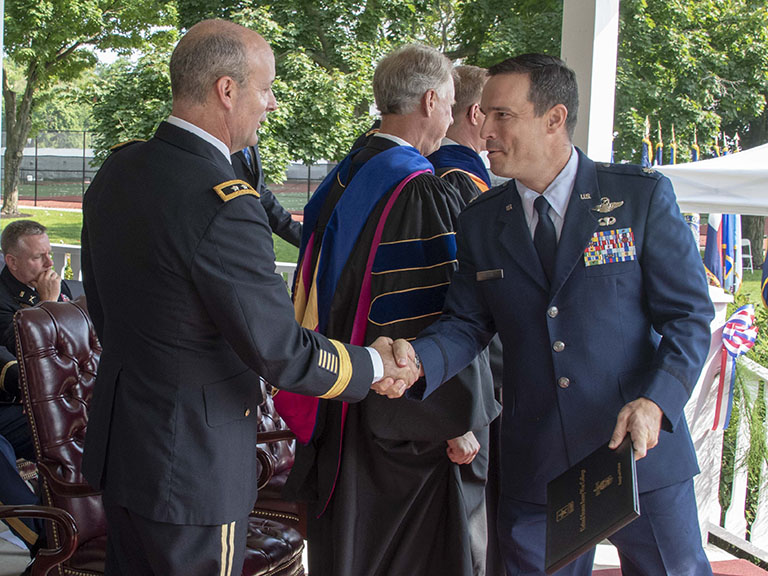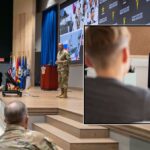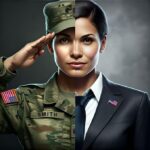
There’s twenty-four outcomes that you’re supposed to do, they would come in and go ‘Prove to me your assessment on all twenty-four of these things.’
The 2018 National Defense Strategy includes the following stark assessment of Professional Military Education, or PME: “PME has stagnated, focused more on the accomplishment of mandatory credit at the expense of lethality and ingenuity.” Externally, PME has been a regular subject of criticism and target of calls for reform for the past decade. But internally, PME institutions have (without much fanfare) been embracing change and innovating their curricula and methodologies to ensure its graduates are prepared to re-enter the joint force with the requisite skills and knowledge. So what continues to be the problem and what barriers still must be overcome. The 51st Commandant of the U.S. Army War College John Kem, who also serves as Deputy Commandant of the Army University, addresses these questions with Andrew A. Hill, WAR ROOM’s Editor-in-Chief.
Podcast: Download
Major General John S. Kem, U.S. Army, is the 51st Commandant of the U.S. Army War College. Andrew A. Hill is Chair of Strategic Leadership at the U.S. Army War College and WAR ROOM Editor-in-Chief. The views expressed in this warcast are those of the speakers and do not necessarily reflect those of the U.S. Army War College, U.S. Army, or Department of Defense.
Photo: Maj. Gen. John Kem, Commandant, congratulates Air Force Lt. Col. John A. Lesho III, who completed the Joint Studies Program and earned Joint Professional Military Education – level II credit, at the USAWC graduation ceremony, July 27, 2018
Photo Credit: U.S. Army War College photo, public domain.





This was an extremely interesting PODCAST. My experience (18 years teaching at the USAWC) is the 2018 National Defense Strategy statement on PME needs close attention. “PME has stagnated, focused more on the accomplishment of mandatory credit at the expense of lethality and ingenuity.” I don’t think the problem is the Senior Service College (SSC) OPMEP. The learning areas are broad enough to provide sufficient freedom for SSCs to execute curriculum as they see fit. The problem, as I see it, is the notion of enhancing “lethality and ingenuity” of students. This is where I saw stagnation.
The NDS also states, ““We will emphasize intellectual leadership and military professionalism in the art and science of warfighting, deepening our knowledge of history while embracing new technology and techniques to counter competitors.” The curriculum needs to balance history while having students think deeply about 21st century warfare at the strategic level. The Army War College needs to address how strategic leaders should think about science and technology, Artificial Intelligence on the Battlefield, robotics, drones, space and cyberspace. These topics need real attention in the curriculum to help our future senior leaders prepare for these new challenges. I believe the ratio of history and its application to 21st century warfare is out of alignment.
Finally, I hope the Army War College is following closely the research of COL Celestino Perez, Department of National Security Studies, on performance learning. There needs to a focus on active learning as the primary educational methodology at the USAWC (and other SSCs). There is room to reduce the many passive learning sessions where seminar dialog and lectures are the primary educational method. The PRIMARY active learning techniques should be wargaming, case studies, exercises, workshops, and other experiential learning (hands on) opportunities. I realize the USAWC uses these techniques now. My problem is with the frequency of the active learning methodology. The active learning opportunities for students will enhance their retention and experience with the complex topics and skills required of senior leaders.
The one example of passive learning that immediately comes to mind is the annual Battlefield tours (Resident and Department of Distance Education) where historians do most of the talking (if not all of the talking) on the battlefield. These learning activities are not Staff Rides in my opinion. Turn these important battlefield visits into true Staff Rides. It would be easy for the historians at the college to prepare a role-playing exercise where the students present on each stop along the battlefield. The historians could guide the presentations and insure the students learn key operational and strategic lessons. Make this an evaluated learning event (oral presentation). The active learning method of true staff rides would insure students retain and achieve learning outcomes for these important trips to the battlefield.
Every lesson should have an active learning component built in to require students to “DO” rather than just “Talk” about complicated issues and topics. I look forward to hearing about the improvements to the curriculum to address more 21st century warfighting topics and the addition of active learning as the primary educational methodologies in the future. Jeff Groh grohj@comcast.net
General Kim mentioned a book he was reading, but not the book name. It sounded like it was on the history of the war college. What was it